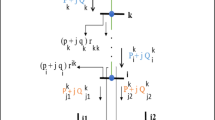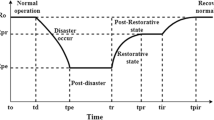Abstract
This paper presents a three-stage stochastic optimization model for the planning of networked microgrids (NMG) that incorporates considerations for seismic activity. Utilizing a combination of Monte Carlo Simulation (MCS) and K-Means clustering, the model effectively generates and reduces earthquake scenarios. An peak-ground acceleration based earthquake propagation model and utilizes fragility curves of critical infrastructures within power systems to develop a comprehensive component failure model are investigated. Monte Carlo simulations are conducted to determine the failure rates of utility transformers, distribution lines, and Distributed Energy Resources (DERs). The planning model is structured in three stages, each targeting specific aspects of microgrid planning. The first stage aims to minimize initial investment costs, the second stage focuses on reducing operational costs under various fault scenarios, and the third stage strives to minimize the unserved load during earthquake events. The model encompasses several investment and operational objectives, including the reduction of capital costs, CO2 emissions, load curtailment costs, and operational costs of DERs, while also considering power generation and flow constraints. The efficacy of the model is demonstrated through its application to a simplified distribution network in Tanjung KOTA on Lombok Island, a region prone to frequent earthquakes. The simulation results show that the proposed NMG not only achieves 100% electrification and significantly reduces CO2 emissions but also enhances the resilience of the power system. This contributes to facilitating a green transition, ensuring robust performance even under seismic challenges.
Supported by organization x.
Access this chapter
Tax calculation will be finalised at checkout
Purchases are for personal use only
Similar content being viewed by others
References
Erdiwansyah, E., et al.: Investigation of availability, demand, targets, and development of renewable energy in 2017–2050: a case study in Indonesia. Int. J. Coal Sci. Technol. 8(4), 483–499 (2021). https://doi.org/10.1007/s40789-020-00391-4
Kurniawan, I., Ichwani, R., Fionasari, R., Batubara, A., Huda, A.: Indonesia’s renewable energy outlook: what to expect in the future renewable energy of Indonesia. a brief review. Elkawnie: J. Islamic Sci. Technol. 8(2), 298–313 (2022)
PT PLN. Rencana usaha penyediaan tenaga listrik (RUPTL) pln. Technical report (2017)
United Nations. Sustainable development goal 7. https://sdgs.un.org/goals/goal7 (2015). Accessed 05 Jul 2021
UN ESCAP. Energy transition pathways for the 2030 agenda: Sdg7 roadmap for Indonesia (2020)
Backhaus, Scott, N., et al.: Networked microgrids scoping study (2016)
Gamarra, C., Guerrero, J.M.: Computational optimization techniques applied to microgrids planning: a review. Renew. Sustain. Energy Rev. 48, 413–424 (2015)
Mendes, G., Ioakimidis, C., Ferrão, P.: On the planning and analysis of integrated community energy systems: a review and survey of available tools. Renew. Sustain. Energy Rev. 15(9), 4836–4854 (2011)
Connolly, D., Lund, H., Mathiesen, B.V., Leahy, M.: A review of computer tools for analysing the integration of renewable energy into various energy systems. Appl. Energy 87(4), 1059–1082 (2010)
Kang, W., et al.: Community microgrid planning in lombok islands: an Indonesian case study. Front. Energy Res. 11, 1209875 (2023)
Sawle, Y., Jain, S., Babu, S., Nair, A.R., Khan, B.: Prefeasibility economic and sensitivity assessment of hybrid renewable energy system. IEEE Access 9, 28260–28271 (2021)
Huang, Y., et al.: Three-phase optimal power flow for networked microgrids based on semidefinite programming convex relaxation. Appl. Energy 305, 117771 (2022)
Fairbrother, J., Turner, A., Wallace, S.W.: Problem-driven scenario generation: an analytical approach for stochastic programs with tail risk measure. Math. Program. 1–42 (2019). https://doi.org/10.1007/s10107-019-01451-7
Kang, J., Wu, Z., Ng, T.S., Su, B.: A stochastic-robust optimization model for inter-regional power system planning. Eur. J. Oper. Res. 310(3), 1234–1248 (2023)
Vera, E.G., Cañizares, C., Pirnia, M.: Geographic-information-based stochastic optimization model for multi-microgrid planning. Appl. Energy 340, 121020 (2023)
Vera, E.G., Cañizares, C.A., Pirnia, M., Guedes, T.P., Trujillo, J.D.M.: Two-stage stochastic optimization model for multi-microgrid planning. IEEE Trans. Smart Grid 14(3), 1723–1735 (2023)
Cui, H., Xia, W., Yang, S.: Two-time-scale dispatch strategy for networked micro-grids considering uncertainties and demand response. Int. J. Electr. Power Energy Syst. 145, 108620 (2023)
Lagos, T., et al.: Identifying optimal portfolios of resilient network investments against natural hazards, with applications to earthquakes. IEEE Trans. Power Syst. 35(2), 1411–1421 (2019)
Byeong-Chan, O., Son, Y.-G., Zhao, D., Singh, C., Kim, S.-Y.: A bi-level approach for networked microgrid planning considering multiple contingencies and resilience. IEEE Trans. Power Syst. 39(4), 5620–5630 (2024)
Sun, X., Cao, X., Zeng, B., Zhai, Q., Guan, X.: Multistage dynamic planning of integrated hydrogen-electrical microgrids under multiscale uncertainties. IEEE Trans. Smart Grid 14(5), 3482–3498 (2022)
US Geological Survey. Earthquake hazards program. https://earthquake.usgs.gov/
Global Seismographic Network. Iris/usgs global seismographic network. https://www.iris.edu/hq/programs/gsn
Boore, D.M., Joyner, W.B., Fumal, T.E.: Equations for estimating horizontal response spectra and peak acceleration from western north American earthquakes: a summary of recent work. Seismological Res. Lett. 68(1), 128–153 (1997)
FEMA. Loss Estimation Methodology, MR4-Multi-Hazard, Earthquake Model, Technical Manual. Federal Emergency Management Agency (2003)
Kang, W., et al.: Stochastic optimal planning of networked microgrids for Indonesia electrification considering various faults, pp. 2287–2292 (2024)
Birge, J.R., Louveaux, F.: Introduction to Stochastic Programming. Springer, Cham (2011)
Kekatos, V., Zhang, L., Giannakis, G.B., Baldick, R.: Voltage regulation algorithms for multiphase power distribution grids. IEEE Trans. Power Syst. 31(5), 3913–3923 (2016)
Madathil, S.C., et al.: Resilient off-grid microgrids: capacity planning and n-1 security. IEEE Trans. Smart Grid 9(6), 6511–6521 (2018)
European Commission, Joint Research Centre. Photovoltaic geographical information system (PVGIS) (2024). Accessed 24 Jan 2024
Acknowledgements
This work was supported in part by VILLUM FONDEN under the VILLUM Investigator Grant (no. 25920): Center for Research on Microgrids (CROM); www.crom.et.aau.dk, and part by Tech-IN project (Granted by Danish Ministry for foreign affairs and supported by Danida Fellowship Centre Under grant 20-M06-AAU); www.energy.aau.dk/tech-in, and part by LastWind project (Granted by Danish Ministry for foreign affairs and supported by Danida Fellowship Centre Under grant 23-M01-AAU).
Author information
Authors and Affiliations
Corresponding author
Editor information
Editors and Affiliations
Rights and permissions
Copyright information
© 2025 The Author(s), under exclusive license to Springer Nature Switzerland AG
About this paper
Cite this paper
Kang, W., Guan, Y., Yu, Y., Vasquez, J.C., Wijaya, F.D., Guerrero, J.M. (2025). Three-Stage Planning of Networked Microgrids for Electrification of Indonesia Islands Considering Earthquake Scenarios. In: Jørgensen, B.N., Ma, Z.G., Wijaya, F.D., Irnawan, R., Sarjiya, S. (eds) Energy Informatics. EI.A 2024. Lecture Notes in Computer Science, vol 15272. Springer, Cham. https://doi.org/10.1007/978-3-031-74741-0_23
Download citation
DOI: https://doi.org/10.1007/978-3-031-74741-0_23
Published:
Publisher Name: Springer, Cham
Print ISBN: 978-3-031-74740-3
Online ISBN: 978-3-031-74741-0
eBook Packages: Computer ScienceComputer Science (R0)




